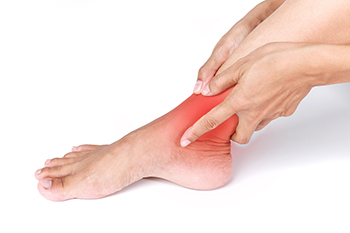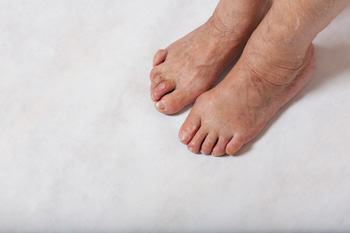Items filtered by date: May 2025
How Running Shoes and Walking Shoes Differ

Running shoes and walking shoes are designed with different purposes in mind, and choosing the right type is important for comfort and injury prevention. Running shoes are built to handle the higher impact and greater force that occurs with each stride. They typically offer more cushioning, flexibility, and support in key areas, such as the heel and forefoot. In contrast, walking shoes are designed for a more consistent, rolling motion of the foot and often feature a more rigid sole with support focused on the arch and heel. The differences in design help accommodate the unique movements of each activity. Wearing the appropriate shoe for your chosen exercise not only improves performance but also supports long-term foot health by reducing strain on muscles and joints during regular physical activity. If you have developed foot pain from wearing the wrong type of shoes for walking or running, it is suggested that you confer with a podiatrist who can offer effective treatment remedies and guide you on what features to look for in desired shoes.
For more information about walking shoes versus running shoes, consult with One of our podiatrist from Santi Podiatry Group. Our doctors can measure your feet to determine what your needs are and help you find an appropriate pair of footwear.
Foot Health: The Differences between Walking & Running Shoes
There are great ways to stay in shape: running and walking are two great exercises to a healthy lifestyle. It is important to know that running shoes and walking shoes are not interchangeable. There is a key difference on how the feet hit the ground when someone is running or walking. This is why one should be aware that a shoe is designed differently for each activity.
You may be asking yourself what the real differences are between walking and running shoes and the answers may shock you.
Differences
Walking doesn’t involve as much stress or impact on the feet as running does. However, this doesn’t mean that you should be any less prepared. When you’re walking, you land on your heels and have your foot roll forward. This rolling motion requires additional support to the feet.
Flexibility – Walking shoes are designed to have soft, flexible soles. This allows the walker to push off easily with each step.
If you have any questions, please feel free to contact our offices located in on 5th Street and Kings Highway Brooklyn, NY . We offer the newest diagnostic and treatment technologies for all your foot care needs.
Get Proper Treatment for Ankle Injuries
Is It a Sprained or Broken Ankle?

Telling whether an ankle injury is a sprain or a fracture can be problematic. A sprained ankle occurs when the ligaments that support the joint are stretched or torn, often from twisting or rolling the ankle. Sprains can range in severity, from mild overstretching to complete ligament tears. In contrast, a broken ankle involves a fracture of one or more bones, typically the tibia, fibula, or talus. A fracture may be simple with a clean break or complex with multiple fragments. While both injuries can cause swelling, bruising, and pain, a fracture often results in more severe pain and the inability to bear weight. Proper diagnosis may require an X-ray to distinguish between the two. Treatment varies significantly, so it is suggested that you promptly consult a podiatrist for an accurate diagnosis and appropriate treatment solutions.
Foot and ankle trauma is common among athletes and the elderly. If you have concerns that you may have experienced trauma to the foot and ankle, consult with One of our podiatrist from Santi Podiatry Group. Our doctors will assess your condition and provide you with quality foot and ankle treatment.
Foot and ankle trauma cover a range of injuries all over the foot; common injuries include:
- Broken bones
- Muscle strains
- Injuries to the tendons and ligaments
- Stress fractures
Symptoms
Symptoms of foot and ankle injuries vary depending on the injury, but more common ones include:
- Bruising
- Inflammation/ Swelling
- Pain
Diagnosis
To properly diagnose the exact type of injury, podiatrists will conduct a number of different tests. Some of these include sensation and visual tests, X-rays, and MRIs. Medical and family histories will also be taken into account.
Treatment
Once the injury has been diagnosed, the podiatrist can than offer the best treatment options for you. In less severe cases, rest and keeping pressure off the foot may be all that’s necessary. Orthotics, such as a specially made shoes, or immobilization devices, like splints or casts, may be deemed necessary. Finally, if the injury is severe enough, surgery may be necessary.
If you have any questions, please feel free to contact our offices located in on 5th Street and Kings Highway Brooklyn, NY . We offer the newest diagnostic and treatment technologies for all your foot care needs.
Repairing a Hammertoe

A hammertoe happens when one of the smaller toes bends abnormally at the middle joint. At first, the toe may still be flexible, but over time it can become stiff and painful. Shoes may rub against the raised joint, causing corns, blisters or swelling. Common causes include wearing poor footwear, muscle imbalance or foot structure. Early treatment may include splints, padding or custom inserts to relieve pressure and correct alignment. When these methods no longer help, surgery may be needed to straighten the toe and restore comfort. Surgical repair can involve removing a small piece of bone, releasing tight tendons or inserting a pin for support during healing. Recovery times vary, but many people return to walking with improved function and less pain. If your toe has become hard to move or to walk on, it is suggested you see a podiatrist to discuss what type of treatment might be most beneficial for you.
Hammertoes can be a painful condition to live with. For more information, contact One of our podiatrist of Santi Podiatry Group. Our doctors will answer any of your foot- and ankle-related questions.
Hammertoe
Hammertoe is a foot deformity that occurs due to an imbalance in the muscles, tendons, or ligaments that normally hold the toe straight. It can be caused by the type of shoes you wear, your foot structure, trauma, and certain disease processes.
Symptoms
- Painful and/or difficult toe movement
- Swelling
- Joint stiffness
- Calluses/Corns
- Physical deformity
Risk Factors
- Age – The risk of hammertoe increases with age
- Sex – Women are more likely to have hammertoe compared to men
- Toe Length – You are more likely to develop hammertoe if your second toe is longer than your big toe
- Certain Diseases – Arthritis and diabetes may make you more likely to develop hammertoe
Treatment
If you have hammertoe, you should change into a more comfortable shoe that provides enough room for your toes. Exercises such as picking up marbles may strengthen and stretch your toe muscles. Nevertheless, it is important to seek assistance from a podiatrist in order to determine the severity of your hammertoe and see which treatment option will work best for you.
If you have any questions, please feel free to contact our offices located in on 5th Street and Kings Highway Brooklyn, NY . We offer the newest diagnostic and treatment technologies for all your foot care needs.
Options for Treating Gangrene

Treatment for gangrene that affects the feet, toes, or ankles focuses on removing dead tissue, fighting infection, and restoring blood flow. A podiatrist may begin by performing debridement. This is a surgical procedure that removes the damaged tissue and helps promote healing. When an infection is involved, antibiotics may be administered through a vein to ensure they reach the affected tissue. If gangrene results from reduced blood supply, surgery may be performed to restore circulation. One method of treating gangrene is bypass surgery, designed to redirect blood flow around a blockage. Another is angioplasty, which uses a small balloon to open a narrowed artery and may include placing a stent. In severe cases, where the affected tissue cannot be saved, loss of a toe or part of the foot may be necessary to prevent the gangrene from spreading. In gangrene linked to diabetic ulcers, hyperbaric oxygen therapy may also be used to increase oxygen levels in the blood and support healing. If you have developed gangrene from a diabetic foot ulcer, it is suggested that you schedule an immediate appointment with a podiatrist for the appropriate wound care.
Wound care is an important part in dealing with diabetes. If you have diabetes and a foot wound or would like more information about wound care for diabetics, consult with One of our podiatrist from Santi Podiatry Group. Our doctors will assess your condition and provide you with quality foot and ankle treatment.
What Is Wound Care?
Wound care is the practice of taking proper care of a wound. This can range from the smallest to the largest of wounds. While everyone can benefit from proper wound care, it is much more important for diabetics. Diabetics often suffer from poor blood circulation which causes wounds to heal much slower than they would in a non-diabetic.
What Is the Importance of Wound Care?
While it may not seem apparent with small ulcers on the foot, for diabetics, any size ulcer can become infected. Diabetics often also suffer from neuropathy, or nerve loss. This means they might not even feel when they have an ulcer on their foot. If the wound becomes severely infected, amputation may be necessary. Therefore, it is of the upmost importance to properly care for any and all foot wounds.
How to Care for Wounds
The best way to care for foot wounds is to prevent them. For diabetics, this means daily inspections of the feet for any signs of abnormalities or ulcers. It is also recommended to see a podiatrist several times a year for a foot inspection. If you do have an ulcer, run the wound under water to clear dirt from the wound; then apply antibiotic ointment to the wound and cover with a bandage. Bandages should be changed daily and keeping pressure off the wound is smart. It is advised to see a podiatrist, who can keep an eye on it.
If you have any questions, please feel free to contact our offices located in on 5th Street and Kings Highway Brooklyn, NY . We offer the newest diagnostic and treatment technologies for all your foot care needs.


